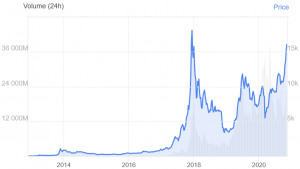6 Most Common Misconceptions About Bitcoin Picked by Lyn Alden
Bitcoin (BTC) is a bubble, too volatile, and has no value – are some of the most common misconceptions popular generalist investor and Swan Bitcoin, a BTC investing app, advisor, Lyn Alden, said she has noticed so far.

Alden writes in her recent post that she turned bullish on bitcoin in April this year, as “a variety of factors turned strongly in its favor.” But during this summer and autumn, Alden says she received numerous questions about BTC, which she summarized in seven common misconceptions.
1. Bitcoin is a bubble
Looking at the charts, from the beginning of 2016 to the beginning of 2019, with bitcoin hitting a peak in late 2017 after a parabolic rise, it’s easy to see why some would think of it as a classic bubble. But it makes more sense to look at it long term, and see that each cycle, with us being in the fourth one since the May halving, saw massive increases.
Learn more: ‘Bitcoin on Track for USD 100,000 in 2025’ – Bloomberg Intelligence
BTC price chart:

2. Bitcoin’s intrinsic value is zero
Bitcoin’s utility lies in the fact that it allows people to store value outside of any currency system in something with a provably hard-capped supply, which is more easily verifiable than gold, and then to transport that value easily across the world. “Bitcoin is the best at what it does,” Alden said. “And in a world of negative real rates within developed markets, and a host of currency failures in emerging markets, what it does has utility.”
Learn more:
A Surprise from JPMorgan: ‘Bitcoin Has Intrinsic Value’
Bitcoin Is Better Than Ethereum At These Four Things
3. Bitcoin isn’t scalable
With any payment protocol, including the traditional ones like Visa, there is a trade-off between security, decentralization, and speed. Bitcoin maximizes security and decentralization, at the cost of speed. But “the key thing to realize is that although Bitcoin is limited in terms of how many transactions it can do per unit of time, it is not limited by the total value of those transactions. The amount of value that Bitcoin can settle per unit of time is limitless, depending on its market cap and additional layers.”
Learn more: Bitcoin And Ethereum Scale Slower Than Cryptoverse Grows
4. Bitcoin wastes energy
“The Bitcoin network currently uses as much energy as a small country,” said Alden, and it needs it because it has massive computing power constantly securing its protocol. The question is whether that energy is put to good use, and so far “the market says it does and I agree,” said Alden. It gives people around the world a choice, while a significant portion of the energy that Bitcoin uses, could otherwise be wasted, as bitcoin mining converts the output from cheap stranded sources of energy.
Learn more: Why Bitcoin’s Energy Consumption May Be a Price Worth Paying
5. Bitcoin is too volatile
For Bitcoin’s market cap to grow from a USD 25m to today’s value of over USD 250bn, it simply needed volatility, especially upward volatility, and that comes with associated downside volatility. “As it grows larger, its volatility reduces over time,” and if bitcoin becomes a USD 2.5tn asset class one day, “with more widespread holding, its volatility would likely be lower than it is now,” Alden said.
Learn more: Brace For More Bitcoin Flash Crashes In This Bull Market – Hut 8 Founder
6. Governments will ban BTC
Some governments have already worked on banning BTC, and they can ban exchanges and make it illegal to own BTC, which would drive out institutional money and put Bitcoin into the black market. However, a lot of big players, be it companies or individuals, are now involved with crypto – working with it or have invested in it – such as MicroStrategy, Square, PayPal, Fidelity, Paul Tudor Jones, US Senator-elect Cynthia Lummis, etc. As the market capitalization grows, it will only become more difficult for the global governments to ban it. However, Alden added that regulatory hostility is still a risk to watch out for while the market capitalization is sub-USD 1tn. Today, it stands above USD 290bn.
Learn more: Response to Ray Dalio: Banning Bitcoin Is a ‘Game of Whack-a-Mole’
__
Meanwhile, in July, Alden estimated that the next bull cycle for bitcoin may bring its price up 2-5 times the price seen during the previous all-time high from December 2017, meaning it could jump to USD 40,000-100,000 a piece.
Now, she continues to be bullish through 2021, and from there “would expect a period of correction and consolidation.”
At the time of writing (14:43 UTC), BTC trades at USD 15,930, dropping from USD 16,125, reached today for the first time since January 2018. The price is still up by almost 3% in a day and 7% in a week. It rallied by 41% in a month and 82% in a year.
____
Learn more:
Can Bitcoin Really be Censored, Controlled, and Mass Surveilled?
7 Biggest Misconceptions About Bitcoin, Picked by 6 Crypto Experts
Vitalik Buterin on The Five Biggest Misconceptions in Crypto




